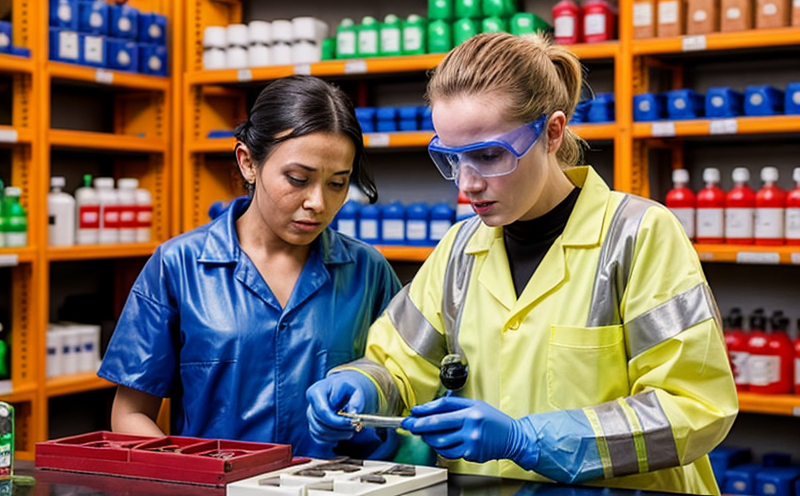ISO 11885 ICP-OES Testing of Metals in Imported Chemicals
The International Organization for Standardization (ISO) 11885:2016 specifies the procedure for determining trace and minor amounts of metals in imported chemicals using Inductively Coupled Plasma Optical Emission Spectroscopy (ICP-OES). This method is crucial for ensuring compliance with trade facilitation regulations, particularly when dealing with hazardous substances. The test ensures that imported chemical products meet stringent international safety standards set by regulatory bodies such as the European Chemicals Agency and the US Environmental Protection Agency.
Traces of metals in imported chemicals can pose significant risks to human health and environmental sustainability. These metals may include lead, mercury, cadmium, arsenic, and other heavy elements that are harmful at low levels. The ISO 11885 ICP-OES test offers a precise, reliable, and cost-effective way to identify these potential hazards early in the supply chain process.
Compliance with this standard is not only essential for importers but also for exporters who aim to ensure their products meet international quality standards. This testing helps prevent the unintentional introduction of harmful substances into the market, thereby safeguarding public health and protecting the environment.
The test involves several key steps:
- Sample preparation: The imported chemical samples are first carefully prepared by dissolving them in suitable acids to release metallic elements for analysis.
- Instrumentation: Samples are introduced into an ICP-OES instrument, which excites metal ions to emit light at specific wavelengths. This allows for the quantitative determination of various metals present in the sample.
- Data analysis: The emitted light is detected and analyzed by a spectrometer, providing accurate concentrations of targeted metal elements.
The results are reported according to ISO 11885 guidelines, ensuring consistency and reliability across different laboratories. Compliance with this standard is increasingly required for importers in the EU and other regions that follow international safety protocols.
For quality managers, compliance officers, R&D engineers, and procurement professionals, ISO 11885 ICP-OES testing is an indispensable tool to ensure product safety and regulatory compliance. By adhering to this standard, organizations can avoid costly recalls and legal issues associated with non-compliance. The test also supports continuous improvement in production processes by identifying potential sources of contamination.
Why It Matters
The importance of ISO 11885 ICP-OES testing cannot be overstated, especially given the increasing global trade in chemical products. Regulatory bodies worldwide are implementing stricter controls on hazardous substances to protect public health and the environment. Non-compliance can lead to severe penalties, including fines, product seizures, and even bans.
For importers, this test ensures that their products meet stringent international safety standards before they enter the market. This not only reduces the risk of legal action but also enhances consumer trust in imported goods. Compliance with ISO 11885 is a key differentiator for businesses aiming to compete effectively in global markets.
For R&D engineers, this testing provides critical data that can inform product development and improvement processes. By identifying potential sources of contamination or unintended metal traces, they can refine their production methods to ensure higher quality products.
The test also supports the broader goal of sustainable trade by minimizing environmental impact. By preventing harmful substances from entering the supply chain, importers contribute to a more responsible global trade ecosystem.
Scope and Methodology
| Parameter | Description |
|---|---|
| Sample Preparation | Dissolution of samples in nitric acid with subsequent dilution. |
| Instrumentation | ICP-OES spectrometer capable of detecting trace elements down to parts per billion (ppb). |
| Data Collection | Spectroscopic measurement and analysis through software interfaced with the instrument. |
| Data Analysis | Quantitative evaluation using calibration curves derived from standard solutions. |
The ISO 11885 ICP-OES testing process is designed to ensure accurate and reliable detection of metal elements in imported chemicals. The methodology follows strict protocols outlined in the international standard, ensuring consistent results across different laboratories.
Why Choose This Test
- Precision: ISO 11885 ICP-OES testing provides high accuracy and precision in detecting trace metal elements, ensuring reliable results.
- Rigorous Compliance: The test aligns with international safety standards set by regulatory bodies like the EU and US EPA.
- Cost-Effective: Early detection of harmful substances prevents costly recalls and legal issues.
- Expertise: Our laboratory is equipped with state-of-the-art ICP-OES instrumentation operated by highly skilled technicians.
- Data Reliability: Consistent results across different laboratories, ensuring trust in the testing process.
- Support for Compliance: Ensures that imported chemicals meet stringent international safety standards.
Selecting this test guarantees compliance with global trade facilitation regulations and enhances your reputation as a responsible and reliable importer. By choosing our laboratory for ISO 11885 ICP-OES testing, you can ensure the safety of your products while minimizing risks associated with non-compliance.





